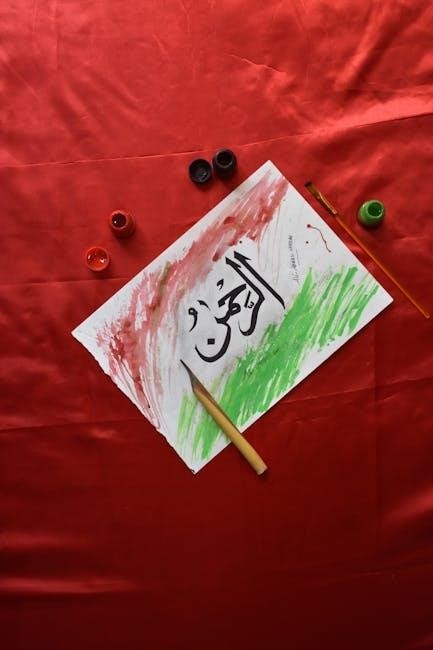Embark on your Arabic learning journey with essential resources designed for beginners; Discover comprehensive PDF guides offering basic Arabic words, phrases, and grammar for everyday conversations and confidence-building.
Importance of Learning Basic Arabic Vocabulary
Mastering basic Arabic vocabulary is essential for building a strong foundation in the language. It unlocks the ability to communicate effectively, understand cultural nuances, and connect with Arabic-speaking communities. Learning common words and phrases enhances everyday interactions, whether for travel, work, or personal growth. PDF guides and resources provide structured lessons, making it easier to grasp vocabulary related to greetings, food, family, and more. These materials often include pronunciation guides and practical exercises, ensuring learners can confidently use their newfound skills. By focusing on basic Arabic words, beginners can gradually expand their knowledge and appreciate the richness of the language and its cultural heritage.
Overview of Arabic Language Basics
The Arabic language is a Semitic tongue written from right to left, consisting of 28 letters in its alphabet. Mastery of these basics is key to understanding and speaking Arabic effectively. PDF guides for beginners often include pronunciation aids, common words, and phrases, divided into sections like greetings, questions, and directions. These resources emphasize foundational vocabulary and grammar, providing structured lessons to build confidence. They are designed to help learners grasp essential communication skills, making them invaluable for those starting their Arabic language journey. By focusing on these fundamentals, learners can progress smoothly to more complex aspects of the language.
Why Start with Common Words and Phrases?
Mastering common Arabic words and phrases is essential for building a strong foundation in the language. These basics enable effective communication in everyday situations, allowing learners to express needs, greet others, and understand responses. Starting with frequently used vocabulary ensures quick progress and boosted confidence. PDF guides often organize these words into categories like greetings, questions, and directions, making them easy to learn and apply. By focusing on practical phrases, beginners can engage in simple conversations early on, fostering motivation and a sense of accomplishment. This approach also lays the groundwork for more complex language skills, making the learning process both enjoyable and rewarding.
Essential Greetings and Phrases
Learn basic Arabic greetings like “Hello” (Salam), “Good Morning” (Sabah el kheer), and “Welcome” (Marhaban). These phrases are crucial for everyday interactions and building connections with Arabic speakers.
Common Greetings in Arabic
Mastering basic Arabic greetings is a great way to start your language journey. Common greetings include “Hello” (Salam), “Good Morning” (Sabah el kheer), and “Good Evening” (Masaa el kheer). Use “Welcome” (Marhaban) to greet someone warmly. For parting, say “Goodbye” (Maa salama) or “See you later” (Araka). These phrases are essential for everyday interactions and show respect for Arabic culture. Learning these greetings will help you connect with native speakers and build a strong foundation for further learning. Practice these words regularly to improve your pronunciation and confidence in using them.
Learning to introduce yourself and engage in basic interactions is crucial for building confidence in Arabic. Start with phrases like “My name is…” (Ismi…), “I am from…” (Ana min…), and “I need…” (Inahtaj…). Common questions include “How are you?” (Kayfa haluka?) and “What is your name?” (Ma ismuka?). Respond with simple answers like “I’m fine, thank you” (Ana bi-khayr, shukran) or “I’m lost” (Ana ta’ish). These phrases help you navigate everyday situations and connect with native speakers. Practice these expressions regularly to improve your communication skills and feel more comfortable in Arabic-speaking environments.
Polite Expressions and Courtesies
Mastering polite expressions in Arabic is essential for respectful communication. Common courtesies include “Thank you” (Shukran) and “You’re welcome” (Afwan). Express gratitude with “Thank you very much” (Shukran jazeelan) or “Thanks be to God” (Alhamdulillah). When offering help, say “Please” (Min fadlak) or “Can I help you?” (Hal bistatee‘id bi shay’?). Apologize with “Excuse me” (A‘oothu billahi) or “Sorry” (Assef). Blessings like “Peace be upon you” (Al-salamu alaykum) and “Goodbye” (Ma’a as-salama) are also important. These phrases demonstrate respect and kindness, making interactions more pleasant and culturally appropriate.

Basic Arabic Vocabulary Categories

Explore essential categories like numbers, family members, food, objects, and time. These foundational topics help build a strong vocabulary base for everyday communication in Arabic.
Numbers and Counting in Arabic
Mastering numbers in Arabic is a fundamental step for beginners. Start with basic counting: 1 (واحد — wāḥid), 2 (اثنان ⸺ ithnān), 3 (ثلاثة — thalāthah), and so on up to 20 (عشرون, ishrūn). These numbers are essential for everyday interactions, such as shopping or telling time. Learning cardinal and ordinal numbers (like أول ⸺ awwal for “first” and ثاني ⸺ thānī for “second”) is crucial. PDF guides often include pronunciation tips and exercises to practice counting. Understanding numbers in Arabic also helps with forming sentences and asking questions, making it a vital part of building a strong vocabulary foundation.
Family Members and Relationships
Learning Arabic words for family members is essential for building a strong vocabulary foundation. Common terms include father (أب — ab), mother (أم, um), brother (أخ ⸺ akh), sister (أخت — ukt), son (ابن ⸺ ibn), and daughter (ابنة ⸺ bint). Understanding these relationships helps in forming basic sentences and engaging in everyday conversations. PDF guides often provide lists of family-related vocabulary, along with pronunciation guides and exercises to practice usage. Mastering these terms is crucial for expressing personal connections and building meaningful interactions in Arabic-speaking contexts.
Food and Drink Vocabulary
Mastering Arabic food and drink vocabulary enhances your ability to communicate in daily life. Essential terms include water (ماء — mā), bread (خبز — khubz), rice (أرز — arz), and dates ( تمر, tamr). Common phrases like “I want to eat” (أريد أن آكل — urīdu an ākul) are also vital. Many PDF guides offer lists of food-related vocabulary, making it easier to learn and practice. Understanding these words helps in ordering food, shopping at markets, and engaging in cultural conversations. Start with basic terms to build a strong foundation for discussing meals and dietary preferences in Arabic.
Common Objects and Household Items
Learning common Arabic words for everyday objects and household items is crucial for effective communication. Essential terms include “book” (كتاب ⸺ kitaab), “house” (بيت ⸺ bayt), “school” (مدرسة — madrasa), and “hospital” (مستشفى ⸺ mustashfa). Familiarizing yourself with words like “water” (ماء — mā), “food” (طعام, ṭaʿām), and “family” (عائلة ⸺ ʿāʾila) helps in daily interactions. Many PDF guides provide visual aids and pronunciation tips, making it easier to recognize and remember these words. Understanding these terms enables you to describe your surroundings, express needs, and engage in conversations about routine tasks and home life.
Useful Phrases for Everyday Situations
Mastering essential Arabic phrases enhances daily interactions. Learn greetings like “Hello” (اهلاً — ahlan) and “Good morning” ( صباح الخير ⸺ sabāh al-khayr).
Asking for Directions
Learning Arabic phrases for asking directions is essential for navigating daily life. Common expressions include “Where is…?” (أين…؟ — Wayn…) and “How do I get to…?” (كيف أذهب إلى…؟ — Kayfa adhabu ilā…). Phrases like “Turn left” (أstupleft — akhudh al-shimāl) and “Turn right” (أstupright — akhudh al-yamīn) are helpful. You can also say “Go straight” (اذهب — idhabb ilā al-amām) or ask for clarification with “Where is the bathroom?” (أين الحمام؟ ⸺ Wayn al-hammām?). These phrases, along with “Here” (هنا ⸺ hunā) and “There” (هناك ⸺ hunāk), provide a solid foundation for seeking assistance in Arabic-speaking environments. Practicing these expressions enhances communication and confidence in real-life situations.
Shopping and Marketplace Phrases
Mastering Arabic phrases for shopping and market interactions is key for a seamless experience. Essential expressions include “How much is this?” (كم ثمن هذا؟ ⸺ kam thaman hadha) and “I want to buy…” (أريد شراء… — urīdu shirāʾ…). Use phrases like “Where is…?” (أين…؟ ⸺ Wayn…) to locate items. Numbers are crucial, such as “one” (واحد — wāḥid) and “ten” (عشرة — ʿashara). Polite expressions like “Give me…” (أعطني… — aʿṭinī…) and “I need…” (أحتاج إلى… — aḥtāju ilā…) are helpful. These phrases enable effective communication in Arabic-speaking markets, aiding in successful transactions and enhancing your shopping experience.
Basic Questions and Requests
Learning to ask basic questions and make requests in Arabic is fundamental for effective communication. Common questions include “What is your name?” (مَا هُوَ اسْمُكَ؟ ⸺ mā huwa ismuka) and “How are you?” (كَيْفَ حَالُكَ؟ ⸺ kayfa ḥāluk). Essential requests like “I need…” (أحتاج إلى… ⸺ aḥtāju ilā…) and “Where is…?” (أين…؟ — Wayn…) are vital for everyday interactions. Phrases such as “Can you help me?” (هل؟ ⸺ hal tastaṭīʿun ṣanāʿatan lī) and “Please repeat” (ال رت FedEx، من فضلك؟ ⸺ alʾafu rati FedEx, min faḍlika) aid in seeking assistance. These expressions enable learners to navigate conversations confidently and effectively.
Arabic Words for Time and Calendar
Mastering time-related vocabulary in Arabic is crucial. Learn days like السبت (as-sabt) and الأحد (al-ʾahad), months like يناير (yanāyir), and common phrases like “What time is it?” (كَم الساعة؟ — kam as-sāʿah).
Days of the Week and Months
Understanding the days of the week and months in Arabic is essential for effective communication. The days are السبت (as-sabt, Saturday), الأحد (al-ʾahad ⸺ Sunday), الاثنين (al-ʾithnayn — Monday), الثلاثاء (ath-thulāthāʾ ⸺ Tuesday), الأربعاء (al-ʾarbiʿāʾ — Wednesday), الخميس (al-khamīs — Thursday), and الجمعة (al-jumʿah, Friday). Months include يناير (yanāyir ⸺ January), فبراير (fabrāyir — February), مارس (mārs — March), أبريل (ʾabrīl, April), مايو (mayū ⸺ May), يونيو (yunyū ⸺ June), يوليو (julāy, July), أغسطس (ʾāghustus — August), سبتمبر (september ⸺ September), أكتوبر (ʾuktōbar ⸺ October), نوفمبر (nūfimbir ⸺ November), and ديسمبر (disember ⸺ December). These terms are often included in basic Arabic PDF guides to help learners master time-related vocabulary for practical communication.
Time-Related Vocabulary
Mastering time-related vocabulary is crucial for effective communication in Arabic. Key terms include “الساعة” (as-sāʿah ⸺ hour), “الدقيقة” (ad-daqīqah ⸺ minute), and “الوقت” (waqt ⸺ time). Common phrases like “كيف الساعة؟” (kayfa as-sāʿah? — What time is it?) are essential. Learners should also understand words like “الآن” (al-ʾān — now), “لاحقًا” (lāḥiqan — later), and “قريبًا” (qarīban ⸺ soon). Terms for morning (الصباح ⸺ as-sabāh), afternoon (الظهيرة — adh-dhuhr), evening (المساء ⸺ al-masāʾ), and night (الليلة — al-laylah) are also vital. These expressions are often included in basic Arabic PDF guides to help learners communicate about time effectively.

Basic Grammar and Sentence Structure
Learn the fundamentals of Arabic grammar and sentence structure to build a strong foundation. Discover how to form simple sentences using basic rules and essential vocabulary for clear communication.
Mastering Arabic grammar rules is essential for building a strong foundation in the language. Arabic grammar, or nahw, governs how words are structured and sentences are formed. Unlike English, Arabic is a Semitic language with a unique system of roots and patterns. Most words derive from three-letter roots, which determine their meaning and function. Understanding vowel markings, or harakat, is crucial for correct pronunciation and comprehension. Arabic also uses a subject-verb-object word order, though flexibility exists. Resources like PDF guides and online tools provide clear explanations and exercises to help beginners grasp these rules. Starting with basic grammar ensures accurate communication and proper sentence formation.
Forming Simple Sentences
Forming simple sentences in Arabic involves understanding word order and basic sentence structure. Arabic typically follows a verb-subject-object (VSO) word order, unlike English’s subject-verb-object (SVO) structure. For example, “Ate the apple” becomes “Ate (verb) the boy (subject) the apple (object).” This pattern helps construct clear and grammatically correct sentences. Beginners can start by combining basic verbs and nouns, using phrases like “أكل التفاحة” (Akle al-tuffaha, “He ate the apple”). PDF guides often provide exercises and examples to practice sentence formation. Mastering these foundational structures is key to building confidence in speaking and writing Arabic effectively.

Resources for Learning Basic Arabic
Explore PDF guides and online tools designed for beginners, offering pronunciation aids, common phrases, and structured lessons. These resources simplify learning and enhance retention of basic Arabic words.
Recommended PDF Guides for Beginners
Discover a variety of PDF guides tailored for Arabic learners, offering comprehensive lists of basic Arabic words, phrases, and pronunciation aids. These resources are designed to simplify learning, with structured lessons and practical exercises. Many guides focus on everyday vocabulary, such as greetings, numbers, and food-related terms, making them ideal for beginners. Some PDFs cater to specific dialects, like Egyptian or Syrian Arabic, while others provide a general introduction to the language. Additionally, some guides include audio files for pronunciation practice, enhancing the learning experience. These free resources are easily downloadable and perfect for self-study, allowing learners to progress at their own pace. They are a valuable starting point for anyone looking to master basic Arabic vocabulary and phrases efficiently.
Online Tools and Apps for Arabic Learning
Enhance your Arabic learning experience with a wide range of online tools and apps designed for beginners. Platforms like Duolingo, Babbel, and Rosetta Stone offer interactive lessons, focusing on basic Arabic words, pronunciation, and grammar. Apps such as Arabicpod101 and Memrise provide audio-based learning and flashcards to memorize vocabulary effectively. Many tools include quizzes, progress tracking, and conversational exercises to practice everyday phrases. These resources are ideal for self-paced learning, offering flexibility and convenience. They complement PDF guides by adding interactive elements, making the learning process engaging and dynamic. Utilize these tools to build a strong foundation in Arabic and improve your language skills effortlessly.
Practice Exercises and Worksheets
Reinforce your learning with practice exercises and worksheets tailored for beginners. Many PDF guides include interactive exercises like matching games, fill-in-the-blanks, and quizzes to test your understanding of basic Arabic words. Online platforms such as ArabicPod101 and language learning websites offer downloadable worksheets that focus on pronunciation, vocabulary, and grammar. These resources help improve retention and provide hands-on experience with the language. Regular practice with these exercises ensures a solid foundation in Arabic, making it easier to progress to more complex lessons. Worksheets often cover essential topics like greetings, numbers, and common phrases, offering a structured approach to mastering the basics.
Your journey to mastering basic Arabic words is complete with these resources. Use the provided PDF guides to continue learning and stay motivated on your path to fluency.
Summarizing Key Takeaways
Learning basic Arabic words is foundational for mastering the language. These PDF guides provide essential vocabulary, phrases, and grammar tailored for beginners. They cover greetings, family terms, food, and common objects, offering practical tools for everyday conversations. Resources like Basic Arabic Words for Beginners and Arabic Vocabulary for Beginners are structured to build confidence and fluency. Many guides include pronunciation tips and thematic arrangements, making learning engaging. These materials are ideal for travelers, students, and enthusiasts, ensuring a solid start in understanding and speaking Arabic effectively.
Encouragement for Further Learning
Mastery of basic Arabic words is just the first step in a rewarding linguistic journey; With the foundation laid, learners can explore more complex vocabulary, grammar, and cultural insights. PDF guides like Learn Arabic Vocabulary with SelfArabic.com and Basic Arabic Expressions offer structured progression, while interactive exercises and audio resources enhance retention. Consistent practice and immersion in the language will deepen understanding and confidence. Embrace the opportunity to connect with Arabic-speaking communities, explore rich literature, and uncover the history behind this beautiful language. Keep exploring, practicing, and enjoying the process of becoming proficient in Arabic!
